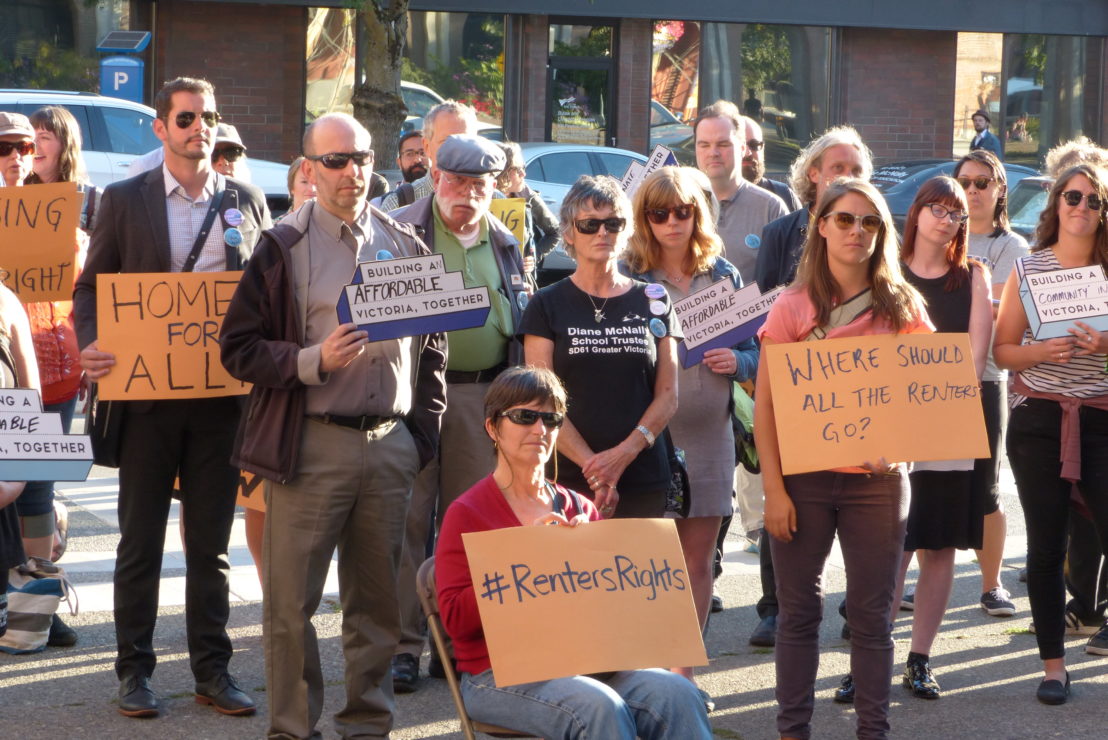Inclusionary housing panel looks at bigger picture

On April 10, the Housing For All community group hosted a panel to discuss upzoning and the proposed changes to Victoria’s inclusionary housing policies. The following day, April 11, Victoria City Council was set to vote on what per cent of new apartment buildings will be required to meet the categorization of ‘affordable’ for those with low incomes.
The proposal was for large housing developments to include 10 per cent of square footage as affordable housing, and smaller developments to make a contribution to the city’s affordable housing fund and to public amenities.
The free event took place at 5:30 p.m. at the Cook Street Activity Centre, but by 5 p.m. the hall was bustling with volunteers and attendees. The crowd was mostly comprised of senior citizens, but there were a few millennials and Victoria City Council members in the audience, too.
Reminiscent of a town hall meeting, people asked questions and cheered at speeches that resonated with them.
There were two speakers lined up to speak followed by a quick question period. Audience members were asked to write their questions on cue cards during the talks, and assistance was offered for those who could not write.
When the allowable density goes up, so does the value of the land. This means the same land will cost more than it does now, which will do nothing to lower rents.
The event began with an acknowledgment of the territory and then Nicole Chaland, former director of Simon Fraser University’s Community Economic Development Programs, began to speak.
Chaland was critical of the proposed inclusionary housing policy. She explained that it would actually be doing less to help those with low income than the current interim policy, because it may not apply to all low-income people and its focus is on quantity.
“[The] inclusionary housing policy assumes that more supply is better. In the short term, it might be creating harm,” said Chaland.
Patrick Condon, the founding chair of the UBC Urban Design Program, was next up to the mic.
Codon expanded on Chaland’s argument regarding quantity of housing units.
He explained that when the allowable density goes up, so does the value of the land. This means the same land will cost more than it does now, which will do nothing to lower rents. New solutions need to be proposed because inclusionary housing policies don’t work, he argued.
“In the city of Victoria, your best bet is to not increase density ever, at all, unless it’s for social [benefit],” said Condon, who frequently writes about the housing crisis in B.C. for the Tyee. This comment was met with applause from the audience.
“The market is not the solution to the problem, the market is the problem,” he said.
The Victoria City Council is open to suggestions and wants to be held accountable, said Victoria Councillor Sharmarke Dubow.
Citing the work of late-18th-century economist Henry George, Condon recommends structuring property taxes so that the land (rather than the buildings on it) is taxed at such a high rate that speculation is disincentivized.
Near the end of the panel, Victoria city councillors recommended that the public come to speak at Council meetings, which are held at 6 p.m. on the second and fourth Thursday of every month.
The Victoria City Council is open to suggestions and wants to be held accountable, said Victoria Councillor Sharmarke Dubow.
Saanich City Councillor Zac De Vries was also in attendance at the panel. He thought the topic of the event was interesting.
“I know we were focused on Victoria today, but the principles are the same,” he said.
But Saanich isn’t planning on copying Victoria’s policies for accessible housing, said De Vries, who graduated from UVic in 2017. Currently, they’re observing what cities all over B.C. are doing, as a sort of “case study” to find the best solution for Saanich.
At the Council meeting on April 11, councillors referred the proposal to City staff, subject to further analysis. They are currently set to make a final decision on May 16.








